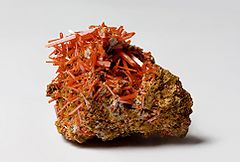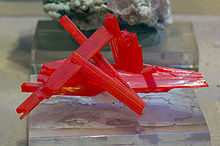- Crocoite
-
Crocoite 
Crocoite from Dundas, Tasmania.General Category Chromate mineral Chemical formula Lead Chromate PbCrO4 Strunz classification 07.FA.20 Crystal symmetry Monoclinic prismatic (2/m) Unit cell a = 7.12 Å, b = 7.421 Å, c = 6.8 Å; β = 102.41°; Z = 4 Identification Color Orange, red, yellow Crystal habit Coarsely crystalline to acicular Crystal system Monoclinic Cleavage Distinct on {110} indistinct on {001} and {100} Fracture Conchoidal to uneven Tenacity Sectile Mohs scale hardness 2.5–3 Luster Adamantine Streak Yellowish orange Diaphaneity Transparent to translucent Specific gravity 5.9–6.1 Optical properties Biaxial (+) Refractive index nα = 2.290(2) nβ = 2.360(2) nγ = 2.660(2) Birefringence δ = 0.370 Pleochroism Weak References [1][2][3] Crocoite is a mineral consisting of lead chromate, PbCrO4, and crystallizing in the monoclinic crystal system. It is sometimes used as a paint, being identical in composition with the artificial product chrome yellow. It was discovered at Berezovsky deposit near Ekaterinburg in the Urals in 1766; and named crocoise by F. S. Beudant in 1832, from the Greek κροκος, saffron, in allusion to its color, a name first altered to crocoisite and afterwards to crocoite. It is found as well-developed crystals, although these are usually poorly terminated. Crystals are of a bright hyacinth-red color, translucent, and have an adamantine to vitreous lustre. On exposure to light much of the translucency and brilliancy is lost. The streak is orange-yellow; Mohs hardness is 2.5–3; and the specific gravity is 6.0. In the Urals the crystals are found in quartz-veins traversing granite or gneiss. Other localities which have yielded good crystallized specimens are Congonhas do Campo near Ouro Preto in Brazil, Luzon in the Philippines, and Mutare in Mashonaland.
Gold is often found associated with this mineral. Exceptional examples of crocoite crystals have been found in the Adelaide Mine at Dundas, Tasmania; they are long slender prisms, 3 to 4 inches (7.5 to 10 cm) in length, with a brilliant lustre and color. Crocoite is also the official Tasmanian mineral emblem.
Associated with crocoite at Berezovsk are the similar minerals phoenicochroite and vauquelinite. The former is a basic lead chromate, Pb2CrO5, and the latter a lead and copper phosphate-chromate, Pb2CuCrO4PO4OH. Vauquelinite forms brown or green monoclinic crystals, and was named after L. N. Vauquelin, who in 1797 discovered (simultaneously with and independently of M. H. Klaproth) the element chromium in crocoite.
Relative rarity of crocoite is connected with specific conditions required for its formation: an oxidation zone of lead ore bed and presence of ultramafic rocks serving as the source of chromium (in chromite). Oxidation of Cr3+ into CrO42- (from chromite) and decomposition of galena (or other primary lead minerals) are required for crocoite formation.
See also
References
 This article incorporates text from a publication now in the public domain: Chisholm, Hugh, ed (1911). Encyclopædia Britannica (11th ed.). Cambridge University Press.
This article incorporates text from a publication now in the public domain: Chisholm, Hugh, ed (1911). Encyclopædia Britannica (11th ed.). Cambridge University Press.
- ^ http://rruff.geo.arizona.edu/doclib/hom/crocoite.pdf Handbook of Mineralogy
- ^ http://www.mindat.org/min-1157.html Mindat
- ^ http://webmineral.com/data/Crocoite.shtml Webmineral data
External links
Categories:- Lead minerals
- Chromate minerals
- Monoclinic minerals
Wikimedia Foundation. 2010.



